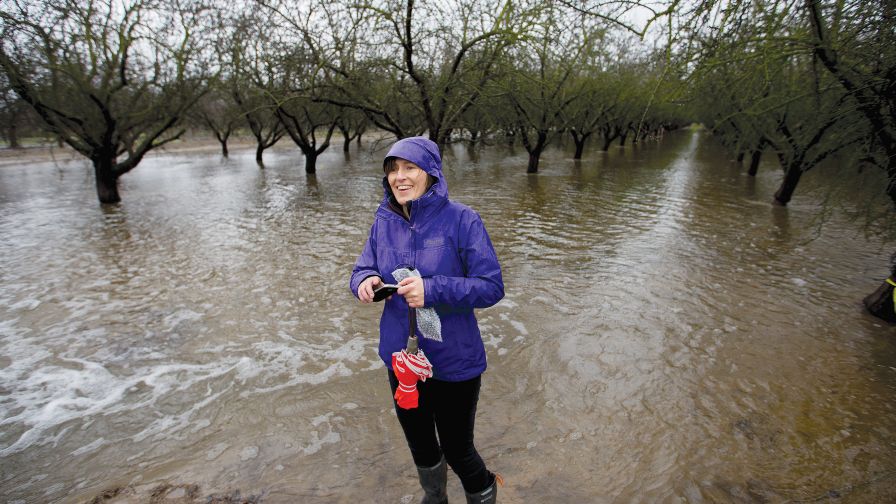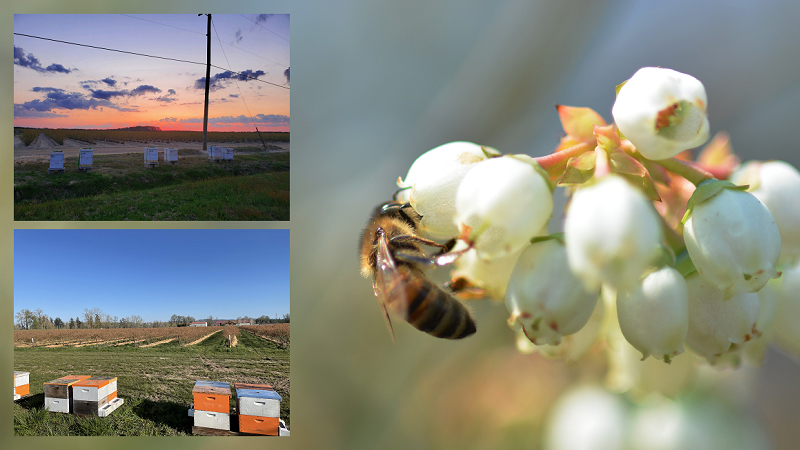Storm Runoff May Recharge Aquifers and Your Crops

Helen Dahlke in one of the study fields in Modesto, CA. Photo courtesy of Joe Proudman/UC Davis.
When it comes to water scarcity, California offers researchers a perfect laboratory. The historic drought it endured over the past few years began impacting groundwater levels, leaving farms few options but to drill deeper and deeper for lower-quality water.
Enter Helen Dahlke, Assistant Professor in Physical Hydrology at University of California, Davis. She headed up a study on how to tap into storm water and winter melt runoff in a way that would not run afoul of California’s strict water rights or environmental laws.
The team wanted to learn how much of the water that was redirected onto the test sites made it below the root zone and into the water table, and if flooding dormant crops had an impact on the next season’s yield.
The results of the University of California, Davis, study are intriguing:
First, water was indeed penetrating to a deeper level.
“Results from our two on-farm experiments indicate that an astoundingly large fraction of the applied winter water percolated past the root zone and was moving toward the groundwater table,” Dahlke wrote in a paper she presented to her colleagues at the 2017 California Plant and Soil Conference. “From the tested winter water application amounts (which ranged between 4 feet and 6.7 feet at the Davis site, and between 2.6 feet and 26 feet at the Scott Valley site), more than 90% of the applied water went to deep percolation.”
Even more promisingly, this method of agricultural groundwater banking seems to have a positive impact on crops, rather than a negative one.
“In the drought year of 2014/2015, test plots, which received winter water applications for recharge late in the winter season (e.g., March/April) showed clearly a higher plant available water content at the onset of the growing season (1 to 2 inches) than the control plots,” she says.
American Vegetable Grower® magazine reached out to Dahlke to learn more.
American Vegetable Grower (AVG): What type of farmland is best suited for recharging with overflow water?
Dahlke: California has about 8 million acres of irrigated farmland that is connected to water or irrigation water conveyance infrastructure (canals, ditches) that could be used to route the water in the winter from rivers to agricultural fields. The water could then be spread to infiltrate into the soil.
In most winters, there is not enough excess surface water available to do recharge on all 8 million acres of irrigated agricultural land and neither should we do recharge on all 8 million acres because it would create a water quality problem.
So, among those 8 million acres, there is a lower percentage of land that has suitable soils for doing groundwater recharge. This has been published in a recent paper (https://is.gd/rechargestudy), where my colleague Toby O’Geen identified that about 3.5 million acres of irrigated land in California have suitable soils for recharge.
AVG: Your team analyzed the amount of water flowing through a stream, and focused in on streamflow that reaches 90th percentile. Why was that your focus?
Dahlke: Our statistical analysis of streamflow data focused on flows above (greater than) the 90th percentile. Those flows are typically the big storm or flood peaks that occur during the winter. The percentile was chosen so that enough water would still flow down a river that environmental flows and urban/industrial water demands are met.
These high flows are also often not included in water availability analyses that the State Water Resources Control Board is undertaking when they review a new water rights application. So these flows are often not accounted for or stored in surface water reservoirs and we should better manage them.
We only looked at the availability of natural streamflow. In a wet year, winter streamflow can be a lot higher than during dry or average years. These flows can fill up reservoirs quickly, which then need to release that water to mitigate flood risk (overtopping of dams). So, often these flows just go out to the ocean.
AVG: California has a unique climate and state regulations. Do you believe your recommended methods would apply to growers outside of the state?
Dahlke: There are many overdrafted groundwater aquifers in other parts of the U.S. (High Plains, TX) and worldwide. The active recharge of groundwater is not a new topic and has been done for decades. It is just that we are realizing more and more how quickly we are depleting our groundwater reserves and that natural recharge from rainfall is not enough to refill groundwater aquifers at the rate at which we are pumping water out. Thus, we need to find ways to support that actively through management. Therefore, this research and management need applies to any groundwater dependent region.
AVG: Your study was conducted on alfalfa stands. Would your findings translate to specialty crop or vegetable growing operations?
Dahlke: We have done on-farm experiments on alfalfa, almonds, and pistachio. But many other cropping systems would most likely work as well. We just didn’t have the chance or funding yet to try it out on other crops.









